
We are a veteran owned company
and proud to say our founder served our country during the Vietnam war.
We are proud to have become the largest supplier of Safety Banners to our Military installations world wide. We ship safety banners to military installations in all 50 states and around the world.
YES!!! - We ship APO/FPO ANYWHERE in the World
Thank You for your service and your sacrifice to our country.
Want a Special safety banner to fit your special need? NO PROBLEM! Give us a call - 901-759-0932, or email us. We can create a special custom banner for your unit or operation at NO Charge for Military design work. (This is for our MILITARY ONLY) Just Ask.
Our U.S. military, and their families, are vital to our country and our future - The UNITED States of America. We urge all our politicians to take all partisanship out of their politics when considering our military personnel, and work tirelessly to improve THEIR safety, THEIR family's security, THEIR ability to get a job and earn a decent living once they have separated and most of all THEIR medical care and well being through the VA Hospitals. They have served us, it is time now for us to serve them. The VA Hospitals should be the gold standard to which all other medical facilities are compared. Our troops and their families DESERVE this level of treatment because of everything they sacrifice to keep you and I safe. We all should contact our Senators and Congressman urging them to properly fund the VA Hospital system and our war fighters healthcare needs.
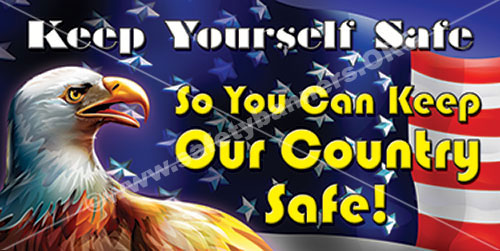
Whenever you see or speak to a military person, I urge you to thank them for their service to our country. They have earned and deserve your appreciation and respect.
Bob Metz, Founder, SafetyBanners.Org
Americas largest designer and producer of industrial safety banners for American manufacturers and warehousing.
Forklift Intersection Floor Stickers that Reduce Forklift & Pedestrian Accidents.
Forklift Intersection Safety THAT WORKS!
• SUPER EASY installation.
• HEAVY DUTY Floor Stickers designed for IN-AISLE USE across your forklift aisles. We designed them to be Forklift-Tough™
• For your Pallet Rack Uprights we designed Aisle Intersection Signs. FLEXIBLE & they bend when struck.
CLICK HERE to order. CLICK HERE to download our informational PDF.
A NEW Low Cost Approach. © 2022, SafetyBanners.Org. All Rights reserved. Patent Applied For.
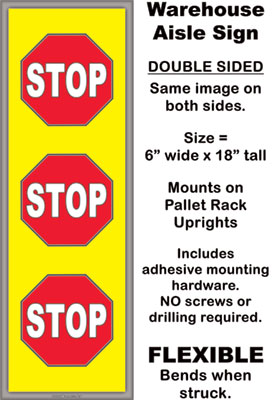
Our forklift intersection iMarker™ safety floor stickers are built to go on the floor IN YOUR FORKLIFT AISLES where your forklifts travel - They are Forklift-Tough™ Our forklift intersection safety floor stickers and hanging banners promote forklift and pedestrian safety in a warehouse and manufacturing environment. All SafetyBanners.Org intersection floor safety stickers are Forklift-Tough™, non-slip, and designed to go in the forklift traffic aisle.
 The intersection is one of the most dangerous places in a warehouse environment. Forklift pedestrian accidents are one of the most reported warehouse incidents. Merely making pedestrians and drivers aware of an intersection can go a long way in accident prevention.
The intersection is one of the most dangerous places in a warehouse environment. Forklift pedestrian accidents are one of the most reported warehouse incidents. Merely making pedestrians and drivers aware of an intersection can go a long way in accident prevention.
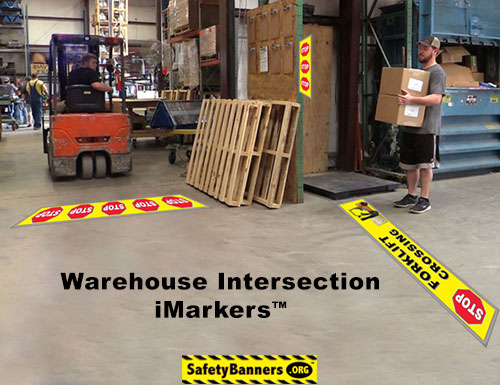 Sometimes a floor sticker is hard for a forklift driver to see, so all our our intersection safety floor stickers are also available as a banner which can be hung above the intersection. Need a custom intersection safety design? Call us - 901-759-0932 - to design one for your particular situation.
Sometimes a floor sticker is hard for a forklift driver to see, so all our our intersection safety floor stickers are also available as a banner which can be hung above the intersection. Need a custom intersection safety design? Call us - 901-759-0932 - to design one for your particular situation.
Forklift / Pedestrian Intersections in a warehouse or any facility can be a very dangerous area. There are a lot of very expensive attempts as solving forklift vs. pedestrian accident solutions. Some work and some not so much. At the end of the day, keeping intersections safe boils down to awareness and forklift drivers and pedestrians paying attention to what they are doing at all time. Distractions and carelessness are the two main causes of intersection accidents. Our goal here at SafetyBanners.Org is to come up with simple, easy to install low cost methods for intersection safety. Our forklift intersection safety floor stickers and our forklift aisle are two of our ideas.
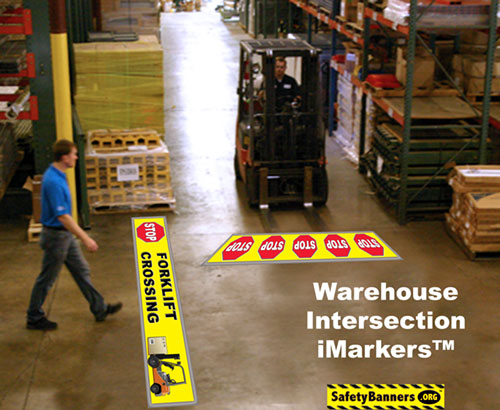
Forklift Intersection Safety Signs for IN-AISLE Forklift and Pedestrian Safety
Strong but Flexible unlike dangerous metal aisle sig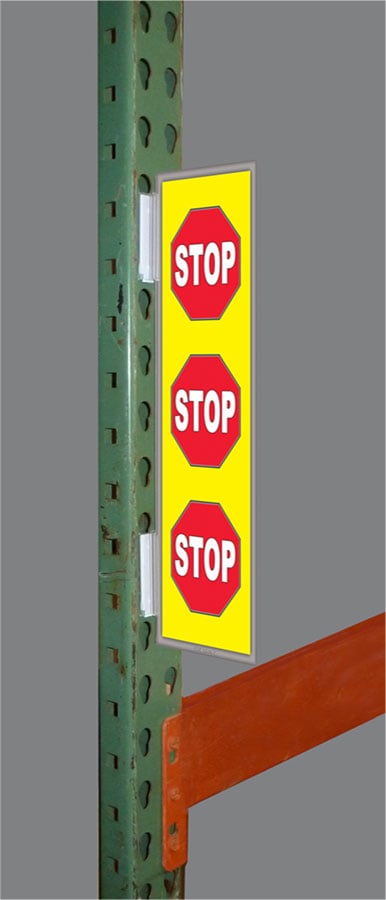 ns.
ns.
INNOVATIVE NEW PRODUCT. © 2017, SafetyBanners.Org. All Rights reserved. Patent Applied For. Patent Applied For.
 Our Forklift Safety Aisle Signs bend when struck unlike dangerous metal signs. Our Forklift Safety Aisle Signs are used for IN-AISLE, EYE HEIGHT safety awareness. They come complete with adhesive backed mounting brackets for your upright support beams or any flat surface. (No drilling or screws required!) They are SUPER EASY to install. They are narrow, 4" wide by 16" tall, double-sided vertical signs, directional in nature, for forklift and pedestrian intersection safety. Flexibility means they bend when struck by a forklift or pedestrian. We made them narrow so they would not interfere with pedestrians or even forklifts in the aisle. However, the design is psychologically eye catching and visually attractive so it is more noticeable than those old style 90's looking signs. They can be placed at eye level without fear of injuring your people which increases the visibility of the sign and the safety message.
Our Forklift Safety Aisle Signs bend when struck unlike dangerous metal signs. Our Forklift Safety Aisle Signs are used for IN-AISLE, EYE HEIGHT safety awareness. They come complete with adhesive backed mounting brackets for your upright support beams or any flat surface. (No drilling or screws required!) They are SUPER EASY to install. They are narrow, 4" wide by 16" tall, double-sided vertical signs, directional in nature, for forklift and pedestrian intersection safety. Flexibility means they bend when struck by a forklift or pedestrian. We made them narrow so they would not interfere with pedestrians or even forklifts in the aisle. However, the design is psychologically eye catching and visually attractive so it is more noticeable than those old style 90's looking signs. They can be placed at eye level without fear of injuring your people which increases the visibility of the sign and the safety message.
You have never seen anything like our Forklift Safety Aisle Signs for in-aisle safety and accident prevention and awareness. Built Ultra Durable and Factory-Tough™ for our American Industry.
© 2022 SafetyBanners.Org, All Rights Reserved. All images and designs are the property of SafetyBanners.Org. Patent Applied For.
Designed and manufactured by SafetyBanners.Org
Memphis, Tennessee
America's largest designer and producer of industrial safety banners and forklift floor stickers for American Industry.